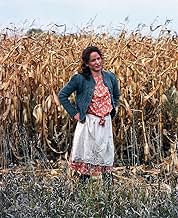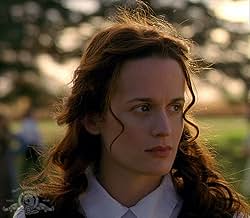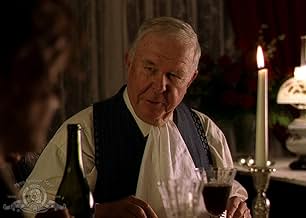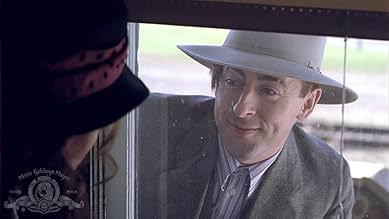CALIFICACIÓN DE IMDb
7.1/10
4.3 k
TU CALIFICACIÓN
Una inmigrante alemana llega a Minnesota en 1920 para casarse con un granjero noruego, pero enfrenta obstáculos burocráticos y prejuicios que ponen en riesgo su futuro juntos.Una inmigrante alemana llega a Minnesota en 1920 para casarse con un granjero noruego, pero enfrenta obstáculos burocráticos y prejuicios que ponen en riesgo su futuro juntos.Una inmigrante alemana llega a Minnesota en 1920 para casarse con un granjero noruego, pero enfrenta obstáculos burocráticos y prejuicios que ponen en riesgo su futuro juntos.
- Premios
- 9 premios ganados y 2 nominaciones en total
- Dirección
- Guionistas
- Todo el elenco y el equipo
- Producción, taquilla y más en IMDbPro
Opiniones destacadas
Delightful, richly imagined story of a young immigrant woman who comes from Norway to Minnesota in 1919 as a "mail order bride" to marry a Norwegian farmer. By turns slapstick funny, tender, ironic and sad, this movie successfully evokes the difficult life of foreign homesteaders in a new land, in a story told simply, with no pretensions and with a wondrous range of nuances.
We confront outrageous instances of religious, ethnic and political bigotry, and the cruel predations of wealthy money lenders who don't blink an eye when pressing foreclosures, ruining families who have sat elbow to elbow with them at church every Sunday for years. But we also see examples of kindheartedness, longing for love and gradually dawning romance, individual integrity and group justice, not to mention hilarious moments, both intentional and unintended.
Inge (Elizabeth Reaser, a luminous beauty) is the stalwart German woman who comes to marry the reticent Olaf (Tim Guinee), who had thought she was Norwegian like him, since she came from a town in Norway. Olaf is a character straight out of a Garrison Keillor monologue: he's the quintessential shy Norwegian bachelor farmer.
Inge, on the other hand, is deferential only because she can't speak English or Norwegian, only German, and that only with the church pastor, Rev. Sorrensen (John Heard), who refuses to conduct the wedding because Inge has no citizenship papers and, ironically, he is suspicious of her German roots, in a time when anti-German sentiment was still at a peak following WW I. Once Inge's got a handle on language, she starts to show her pluck, for, beneath her stunning physical beauty, Inge is in fact a forceful woman.
Comic relief is afforded in a marvelous turn by Alan Cumming as Frandsen, another - and altogether inadequate farmer. Rather than actually work at farming, Frandsen would much rather entertain his wife and nine kids, and his friends, with funny gestures and tunemaking. Cumming's performance reminds me of Ray Bolger as the scarecrow in Wizard of Oz, or Håkan Hagegård, as Papageno in Bergman's "The Magic Flute," or some of the masters of physical comedy in the silent film era. Rounding out a superb cast are Ned Beatty as Harmo, a ruthless banker, and Alex Kinston as Frandsen's wife, Brownie.
Director Ali Selim, a native of St. Paul, Minnesota, had a highly successful career making commercials for television before undertaking this picture, his debut feature narrative film. He worked from a short story by Bemidji writer Will Weaver, called "Gravestone Made of Wheat." The movie was shot on location in a rural area of southwest Minnesota. This film will leave you laughing and crying. It is a treasure. (In English, German and Norwegian) My grades: 8.5/10 (A-) (Seen on 12/26/06)
We confront outrageous instances of religious, ethnic and political bigotry, and the cruel predations of wealthy money lenders who don't blink an eye when pressing foreclosures, ruining families who have sat elbow to elbow with them at church every Sunday for years. But we also see examples of kindheartedness, longing for love and gradually dawning romance, individual integrity and group justice, not to mention hilarious moments, both intentional and unintended.
Inge (Elizabeth Reaser, a luminous beauty) is the stalwart German woman who comes to marry the reticent Olaf (Tim Guinee), who had thought she was Norwegian like him, since she came from a town in Norway. Olaf is a character straight out of a Garrison Keillor monologue: he's the quintessential shy Norwegian bachelor farmer.
Inge, on the other hand, is deferential only because she can't speak English or Norwegian, only German, and that only with the church pastor, Rev. Sorrensen (John Heard), who refuses to conduct the wedding because Inge has no citizenship papers and, ironically, he is suspicious of her German roots, in a time when anti-German sentiment was still at a peak following WW I. Once Inge's got a handle on language, she starts to show her pluck, for, beneath her stunning physical beauty, Inge is in fact a forceful woman.
Comic relief is afforded in a marvelous turn by Alan Cumming as Frandsen, another - and altogether inadequate farmer. Rather than actually work at farming, Frandsen would much rather entertain his wife and nine kids, and his friends, with funny gestures and tunemaking. Cumming's performance reminds me of Ray Bolger as the scarecrow in Wizard of Oz, or Håkan Hagegård, as Papageno in Bergman's "The Magic Flute," or some of the masters of physical comedy in the silent film era. Rounding out a superb cast are Ned Beatty as Harmo, a ruthless banker, and Alex Kinston as Frandsen's wife, Brownie.
Director Ali Selim, a native of St. Paul, Minnesota, had a highly successful career making commercials for television before undertaking this picture, his debut feature narrative film. He worked from a short story by Bemidji writer Will Weaver, called "Gravestone Made of Wheat." The movie was shot on location in a rural area of southwest Minnesota. This film will leave you laughing and crying. It is a treasure. (In English, German and Norwegian) My grades: 8.5/10 (A-) (Seen on 12/26/06)
10takng
Sweet Land touched my heart. My roots are from the same farming background as Olaf and Inge's. Seeing them brought back stories and memories of my own growing up and family history. It slowed down the pace for just a little while and brought back into focus what should really matter in life--and that is the people you journey though it with. The story is simple and yet it is far deeper and more touching than most movies that hit the screen today. It is a story of hardship and the joy and pride that come from hard work. It is a love story and a story of strength. And it is a story with humor and valuable lessons that I believe America's heartland was raised on. It also shares a mindset of a time gone by, an understanding of why our grandparents and parents thought as they did and believed the things they believed. When we know and understand the past, it helps shape and lead us to the future. I appreciate the time and energy that went into the making of this film. It is a treasure.
10Red-125
Sweet Land (2005) was written and directed by Ali Selim. Elizabeth Reaser plays Inge, a mail-order bride who travels to Minnesota to marry Olaf (portrayed by Tim Guinee).
Because Inge is from Germany, not from Scandinavia, she finds social and legal obstacles to her wedding. The plot proceeds from this significant problem.
Tim Guinee is a strong actor, as are some of the actors in supporting roles: John Heard as the troubled Minister Sorrensen, Ned Beatty as Banker Harmo, and Alex Kingston as farm housewife Brownie.
However, the movie belongs to Elizabeth Reaser. She is a brilliant actor. She's even more talented than we realize. She doesn't speak German, but in the film she had to speak German as if it were her first language. Also, she had to speak English with a German accent. Somehow, she carries it off.
It's worth mentioning one aspect of the movie that was unintentionally funny. Reaser has been traveling across the ocean and then halfway across the continent. She arrives looking fresh and tidy. She continues to be fresh and tidy--without a bath--for days after she arrives. Similarly, Alex Kingston is supposed to be a farm housewife who is the mother of nine children, but she still looks youthful and slender. OK--they're beautiful women, but director Selim should have given them a few signs of wear.
I enjoyed this film, and I recommend it highly. We saw the film on DVD, where it worked well. The movie has a strong IMDb rating of 7.3. I think that it's even better than that.
Because Inge is from Germany, not from Scandinavia, she finds social and legal obstacles to her wedding. The plot proceeds from this significant problem.
Tim Guinee is a strong actor, as are some of the actors in supporting roles: John Heard as the troubled Minister Sorrensen, Ned Beatty as Banker Harmo, and Alex Kingston as farm housewife Brownie.
However, the movie belongs to Elizabeth Reaser. She is a brilliant actor. She's even more talented than we realize. She doesn't speak German, but in the film she had to speak German as if it were her first language. Also, she had to speak English with a German accent. Somehow, she carries it off.
It's worth mentioning one aspect of the movie that was unintentionally funny. Reaser has been traveling across the ocean and then halfway across the continent. She arrives looking fresh and tidy. She continues to be fresh and tidy--without a bath--for days after she arrives. Similarly, Alex Kingston is supposed to be a farm housewife who is the mother of nine children, but she still looks youthful and slender. OK--they're beautiful women, but director Selim should have given them a few signs of wear.
I enjoyed this film, and I recommend it highly. We saw the film on DVD, where it worked well. The movie has a strong IMDb rating of 7.3. I think that it's even better than that.
Sadly, if something isn't blowing up or someone isn't sawing someone's limb off, too many people and kids have become numb to violence and need a more violent fix that never gets satisfied. This is a wonderful glimpse into the hard life of being an immigrant from a foreign land, just like today, but even harder. Great casting supported by wonderful cinematography, and yes...story line. Like many of our ancestors, yet we forget wanting to shut the door behind us and not accept and celebrate this wonderful world of variety. Please give it a chance and be patient and not expect a James Bond action thriller. See it with open eyes and context it was meant to be viewed in.
This film is most absorbing, but you have to be willing to watch a film that unfolds slowly. It is magnificently acted with two young actors -- Elizabeth Reaser and Tim Guinee as the leads. There is relatively little dialogue, and much of it is in German or Norwegian with no subtitles, which conveys to the audience the difficulty that they have communicating with each other.
The two leads are heavily dependent upon the expressiveness of their eyes, which they do with great delicacy. The film is well-paced and beautifully photographed. The only difficulty I had was catching on that the action took place in three time periods, not just two. You had 1920 when Inge, a mail order bride comes to rural Minnesota. (The scenery looked authentic, and since some of the credits are for institutions in Montevideo, MN, a town to which I once traveled, I can understand the veracity of the setting.)
The second time period, which is not so clear, is when Olaf, Inge's husband has passed away, and the third time period is more or less the present when Inge's grandson is faced with a decision of whether or not to sell the farm. There are some visual clues to separate the second and third time periods, but they are quite subtle.
The second is probably around 1960, marked by the glasses frames that Inge, as an old woman is wearing; and the third, by a jacket that her great-granddaughter is wearing. Otherwise, the time differences are not totally clear, particularly at the beginning of the film, where you have flashbacks.
The film struck me with its apparent accuracy. Twenty years ago, I knew an elderly Norwegian immigrant who had been the wife of a North Dakota farmer, and she had told me stories of farm life in the 1920s and 1930s. It required about 15 people to operate a steam threshing machine, and she told me about preparing lunch each day during the harvest season for 20 men; and about reading by candlelight at night; using an indoor pump at the sink; and seeking to keep warm during the brutal North Dakota winters.
I visited the woman and her daughters and grand-daughter in her modern apartment which was a far cry from life during her youth. It blows me away to think about the change in this one woman's singular life from her youth to her later years -- greater changes than in any prior period in history. (In 1946, there were still more horse drawn tractors than mechanized ones in use in the U.S., and there wasn't much electricity in rural areas until the New Deal.)
Although I may have missed some, I perceived no wrong notes in the film which added to the enjoyment of watching it. A most charming film from beginning to end.
The two leads are heavily dependent upon the expressiveness of their eyes, which they do with great delicacy. The film is well-paced and beautifully photographed. The only difficulty I had was catching on that the action took place in three time periods, not just two. You had 1920 when Inge, a mail order bride comes to rural Minnesota. (The scenery looked authentic, and since some of the credits are for institutions in Montevideo, MN, a town to which I once traveled, I can understand the veracity of the setting.)
The second time period, which is not so clear, is when Olaf, Inge's husband has passed away, and the third time period is more or less the present when Inge's grandson is faced with a decision of whether or not to sell the farm. There are some visual clues to separate the second and third time periods, but they are quite subtle.
The second is probably around 1960, marked by the glasses frames that Inge, as an old woman is wearing; and the third, by a jacket that her great-granddaughter is wearing. Otherwise, the time differences are not totally clear, particularly at the beginning of the film, where you have flashbacks.
The film struck me with its apparent accuracy. Twenty years ago, I knew an elderly Norwegian immigrant who had been the wife of a North Dakota farmer, and she had told me stories of farm life in the 1920s and 1930s. It required about 15 people to operate a steam threshing machine, and she told me about preparing lunch each day during the harvest season for 20 men; and about reading by candlelight at night; using an indoor pump at the sink; and seeking to keep warm during the brutal North Dakota winters.
I visited the woman and her daughters and grand-daughter in her modern apartment which was a far cry from life during her youth. It blows me away to think about the change in this one woman's singular life from her youth to her later years -- greater changes than in any prior period in history. (In 1946, there were still more horse drawn tractors than mechanized ones in use in the U.S., and there wasn't much electricity in rural areas until the New Deal.)
Although I may have missed some, I perceived no wrong notes in the film which added to the enjoyment of watching it. A most charming film from beginning to end.
¿Sabías que…?
- TriviaElizabeth Reaser' Norwegian pronunciation was so bad that after Dagbladet (one of Norway's biggest news-papers) stumbled upon this film, they posted a clip from it with the title "What is she trying to say?"
- ErroresThey harvest an entire field of corn between the two of them, when they get back to the barn, the crop is suddenly wheat. They go through the whole "separating the wheat from the chaff" process, and pour the seed into sacks.
- Citas
Old Inge: Olaf died, Frandsen.
Old Frandsen: [considering for a moment] No. Olaf is in the fields.
Old Inge: [slowly glancing out the window and remembering]
- Bandas sonorasEskimo Kisses
Music and Lyrics by Thomas Lieberman (as T.F. Lieberman)
Published by Liza Rose Music (ASCAP)
Performed by Thomas Lieberman (as Tom Lieberman)
Selecciones populares
Inicia sesión para calificar y agrega a la lista de videos para obtener recomendaciones personalizadas
- How long is Sweet Land?Con tecnología de Alexa
Detalles
- Fecha de lanzamiento
- País de origen
- Sitio oficial
- Idiomas
- También se conoce como
- Wedding Photo
- Locaciones de filmación
- Productoras
- Ver más créditos de la compañía en IMDbPro
Taquilla
- Presupuesto
- USD 1,000,000 (estimado)
- Total en EE. UU. y Canadá
- USD 1,706,325
- Fin de semana de estreno en EE. UU. y Canadá
- USD 41,860
- 15 oct 2006
- Total a nivel mundial
- USD 1,843,537
- Tiempo de ejecución1 hora 50 minutos
- Color
- Mezcla de sonido
- Relación de aspecto
- 1.85 : 1
Contribuir a esta página
Sugiere una edición o agrega el contenido que falta


































